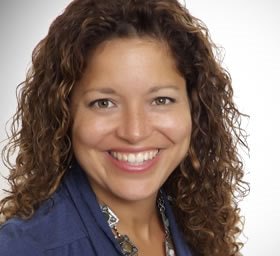 Kerry Ann Rockquemore, president and CEO of the National Center for Faculty Development & Diversity, says the “guru mentor model” isn’t even a healthy model because its based on dependency.
Kerry Ann Rockquemore, president and CEO of the National Center for Faculty Development & Diversity, says the “guru mentor model” isn’t even a healthy model because its based on dependency.In order to increase and maintain gender and ethnic diversity within the STEM professoriate, the “guru mentor model” should be scrapped and replaced with a more thoughtful approach to the specific needs that new STEM faculty members have as they seek to launch their careers.
That was one of the key recommendations made Wednesday at a panel discussion that focused on what it takes to attract and keep more ethnic minorities and women in STEM faculty positions in order to break the cycle of the lack of role models from the same backgrounds as students who aspire to become professors.
“The biggest problem of all is that we somehow imagine that people can only be mentored in their specific field,” said Kerry Ann Rockquemore, president and CEO of the National Center for Faculty Development & Diversity.
“I think we need to fundamentally rethink mentoring, because ultimately this model that most people have in mind not only does it not work for most people most of the time, it’s not even what I would consider a healthy model because it’s a dependency model. People are going to one person over and over again to get their needs met.”
A better approach, Rockquemore said, would be to focus on people’s specific needs—whether it’s how to win an NIH grant, teach a larger class or establish one’s authority in a classroom where students are skeptical of their credentials because of prejudice against their background.
The best person to go to is one who has the particular expertise that a given faculty member needs at a given time.
“Whether you call them a mentor doesn’t matter,” Rockquemore said. “What matters is being surrounded by a wide network of people that you can talk with for advice.”
Rockquemore made her remarks at the American Institutes for Research in Washington, D.C., during a panel discussion titled “Breaking the Mold: Diversifying STEM Academia.”
Courtney Tanenbaum, Senior Researcher at AIR, said lack of diversity in STEM academia “sends cultural signals that constrain choices” and causes a dearth of role models and mentors and hinders new perspectives and approaches to research.
She presented statistics that show men are more likely than women—70 percent versus 65 percent—to secure a position upon earning a STEM Ph.D. and that minority women and mothers are even less likely to have secured a position, with only 59 percent having done so upon earning a STEM Ph.D.
Although women are more likely than men to start their careers in academia, there are also disparities between male and female STEM Ph.D.s who secure positions at research institutions—81 percent of men secured such positions versus 76 percent of women. Similarly, 75 percent of male Ph.D.s who were fathers secured positions at research institutions versus 70 percent of mothers. Tanenbaum said there is also a “low visibility” of female STEM Ph.D.s who go into non-academic careers working in Research and Development. Sixty-one percent of male STEM Ph.D.s secure such positions versus 46 percent of women.
Tanenbaum also presented statistics that show:
• Female STEM Ph.D. holders are less likely than male STEM Ph.D. holders to hold management positions in non-academic STEM careers. The percentage of men from various ethnic groups in management positions ranged from 42 percent for Blacks to 61 percent for Hispanics, but, for women, it ranged from a low of 25 percent for Hispanics to 34 percent for Blacks.
• Women and Blacks are more likely to leave STEM careers than other groups. Specifically, 19 percent of women leave STEM careers versus 16 percent of men; and 21 percent of Blacks leave STEM careers compared with 17 percent of Whites and 14 percent of Asians and Hispanics. Black women were the most likely of all groups to leave, which they did at a rate of 22 percent.
• STEM doctorates cost more for Blacks and Hispanics. Specifically, 25 and 14 percent of African-Americans and Hispanics, respectively, have more than $30,000 in debt for their doctorates in STEM versus just 10 percent of Whites and Asians.
Michael J. Feuer, Dean of the Graduate School of Education & Human Development, said that, although some of the gaps cited by Tanenbaum are small and suggest that efforts to diversify campuses are beginning to yield results, it’s important for institutions not to slip into a state of complacency.
“Even if the differences are really small and they seem manageable and it seems like we’ve made progress, that should embolden us to keep working on it, not say: ‘Problem solved,’” Feuer said.
Feuer said diversity in department-based efforts must be achieved in different ways. He said it’s better to have faculty collaborate on a particular problem instead of trying to get members of various groups together.
Rockquemore said faculty who are members of underrepresented groups face additional pressures in their careers when they are constantly asked to represent their particular group on one or another committee.
“Their time is pressured because they’re getting all of these things coming at them from so many different places, and that time crunch then results in building pressures around the type of scholarly reputation, the type of work that is needed to get tenure,” she said. “If we take serious this idea that women and faculty of color have this additional set of pressures, how do we put meaningful things in place that help people work at their highest potential,” Rockquemore said.















